VOL.49, NO. 3
World Building across Media and the Problem of Authorship in Ash Is Purest White
Zhu Xuefeng (Nanjing University, China)
The sixth-generation Chinese film auteur Jia Zhangke is known for his systematic representation of the complex, fluctuating social reality in China today and its deep historical roots. Aesthetically, what interests the critics most is his constant shuttling between feature and documentary and his attempt to hybridize and disrupt both in a single work. Some have related this aesthetic to his metacinematic attention to media. Rey Chow argues that Jia’s major films up to 2010 have launched a conceptual project of “hypermedial display,” which mourns “the past not as a bygone reality, already well understood, but rather as a (re)collection, one that curates materials in fragmented form from different media” (199-200). In their seminal book Remediation (1999), Jay David Bolter and Richard Grusin have defined “hypermediacy,” the counterbalance of the representational practice and cultural logic of immediacy, as “a heterogeneous space, in which representation is conceived of not as a window on to the world, but rather as ‘windowed’ itself—with windows that open on to other representations or other media” (33-4). In this view, Jia’s filmmaking, despite its claim to reality, seems to offer nothing but a representation of representation.
According to Lars Elleström, however, Bolter and Grusin’s “all-embracing concept of remediation is not designed for analyzing the processes in detail” (“Transmediation” 3). He prefers to divide such processes of “media transformation” into two types: transmediation, which refers to “repeated representation of media traits,” and media representation, which means “representation of another medium” (4). This distinction may shed a new light on media transformation in Jia’s oeuvre, especially his recent feature films. Since 2013 the director has consciously and controversially swerved to popular genre filmmaking, which disturbed the critical consensus in and outside China that used to see him as an arthouse film auteur. A Touch of Sin (2013) is a crime film harkening back to the martial arts genre in Chinese cinema to explore the contemporary social problem of violence (Jia, “Lecture Six”). Mountains May Depart (2015) is a family melodrama intending to show how new technologies such as the Internet and high-speed rail have “altered our emotional paradigm” (Jia, Jia Zhangke Speaks Out II 206-7). Ash Is Purest White (2018, hereafter Ash), especially, adopts the tripartite structure of classical Hollywood, plus familiar genre elements, to focus on a love story previously unthinkable for the director (Jia, Jia Zhangke Speaks Out 231), and recycles bits and pieces from his earlier works to construct “a cinematic universe,” surely a sign of declining creativity for many disappointed critics. This popular turn is nevertheless a mindful response to the ever more media-saturated post-WTO China. As the director recently explains, his genre filmmaking started with A Touch of Sin in 2013, when he kept seeing genre elements while reading news reports about violent events (Jia, “Lecture Six”). A Touch of Sin is therefore not an immediate representation of reality, but a transmediation of already mediated events. If we perceive Jia’s previous films as an auteur’s cinematic world building project which attempts to, as some have argued, “cognitively map” the rapid and massive social change in contemporary China (X. Zhang 141; Hui 265; Andrew 66), then Ash is an indispensable building block rather than a crumbling piece in that world.
This article draws on Elleström’s distinction between transmediation and media representation to scrutinize how Ash extends Jia’s world building project through media transformation. The film transmediates Chinese literary traditions and remixes them with popular film genres to build a media-savvy, heteroglossic auteurist world that historically addresses the complex social changes in post-WTO neo-liberalizing China. The genre mashup enables the auteur to investigate the powerful role media play in the process of urbanization and globalization, focusing especially on how revolutions in media technology impact ordinary Chinese people’s subjectivity formation. Presenting the main characters as learning spectators in this world, contrasting mass screen media and popular theatre through media representation, the film celebrates intersubjectivity and emotional sharing while lamenting ruins caused by competitive dream. Emotional sharing among dis-identified spectators in an aesthetic community is also the only redeeming force when, with a paradoxical lyrical subjectivity, the film’s intermedial auteurism seems to give way to digital pessimism in the end. After production, Ash resorts to social media promotion to further extend Jia’s transmedia world building in real life. The divided social media reception of this film raises further questions about the political efficacy of authorship in the politicized convergence culture of today’s China.
Transmediating the Literary: An Auteur’s Genre Film
Jia’s popular turn is a timely step for his world building project that constantly crosses borders between fiction and reality. If Jia’s early feature films such as his hometown trilogy are more or less documentary, then his recent features tend to show a higher degree of fictionality. A Touch of Sin transmediates the already mediatized news narratives, the third part of Mountains May Depart is set in an even more media-saturated 2025, and Ash ends with a surveillance image that subverts its own Hollywoodish transparency. Jia’s cinematic world is becoming ever more fictionalized because the real world itself seems to be disappearing in the age of Internet and information. The tandem between media and reality, knotted by genre, is key to understanding the new direction in his film aesthetic. Genre, according to Elleström, is a submedium or “a qualified media type that is qualified also within the frames of an overarching qualified medium” (Introduction 64). This “qualified submedia type” (78) carries artistic rules and social conventions that the artist and audience agree upon, and it is prone to change as the agreement changes over time. Jia Zhangke’s Ash, however, seeks to break such rules and conventions with transmediated literary traditions. Hardly a compromise with commercialism, Ash creates an auteur’s genre film to constitute a culturally and aesthetically more expansive cinematic universe.
The Chinese literary tradition of martial arts fiction overrides Ash as a titular metaphor. As indicated by its Chinese title Jianghu ernü (literally “Man and Woman of Rivers and Lakes”), the film is set in the 21st-century urban China but rooted in a generic storyworld that recurs in traditional and modern Chinese literature.1 The multivalent term Jianghu may refer to the entire world, echoing the Confucian doctrine “around the four seas all men are brothers” (Analects). Or it may refer to the lawless world of swordsmen, central to martial arts novel that rose in the early nineteenth century as a transmedia phenomenon that hybridized storytelling, singing, and entrenched literary tradition (Wei 327). The tremendous popularity of the martial arts novel across the Sinophone world in the twentieth century, moreover, has made this genre a fertile site for further transmediations across borders of literature, film, theatre, television, video game, and all varieties of other new media. In Ash, when the leading gangster couple discuss the meaning of jianghu in Act One, Bin the No. 2 gangster in the secluded city of Datong suggests that jianghu simply means social arena or pervasive human competition for profit and power. That explains why he will dream of making a comeback after an untimely fall at the height of his gangster career. Bin’s girlfriend, Qiao, on the other hand, adopts a socialist discourse to dismiss jianghu as symptomatic of “old China before liberation.” As a keen observer of the gangland brotherhood, she has nevertheless internalized traditional values and will choose prison over freedom to save her boyfriend and cover up his crime. By setting itself in the semiotic complexity of jianghu, Ash weaves an intricate web of transmedial links to both popular film genres and Chinese literary traditions.
The three parts respectively parody the sub-medium generic norms of Hong Kong gangster movie, Hollywood road movie, and Chinese domestic melodrama through literary transmediation. The first part seems to follow but actually subverts the scenario of Hong Kong gangster movie, an urban offshoot of martial arts film under the influence of Hollywood gangster genre. Act One theatrically starts with a strongman show set on 2 April 2001, historically the date of a national conference on public security that reached the official decision to rigorously crack down on criminal acts. At the end of that year, China joined the WTO. Set in “the moment to witness a miracle,” as per the strongman performer who raises a bicycle with his teeth to the tune of “A Man Should Stand Strong,” theme song of Hong Kong martial arts film Once Upon a Time in China (Tsui Hark, 1991), Ash unfolds with a new era for all the people in China. Brotherhood, a major principle of the traditional underworld, has been a leitmotif in Hong Kong gangster film. Ash adopts this leitmotif but more explicitly relates it to Water Margin (cir. 14th century) and Romance of the Three Kingdoms (cir. 14th -15th century), the two most popular vernacular novels for the masses of imperial China (Lu 278), which have inspired numerous transmedia adaptations familiar to contemporary Chinese audiences.
The leading gangsters, Eryong and Bin, talk about the future of Datong as if they were politicians of a state in Romance of the Three Kingdoms, while in fact one of them was a villager and the other a laid-off worker, therefore each previously disadvantaged like heroes in Water Margin before their rebellion. But the gangster underworld in Ash is transforming into a business arena as the nation transitions into a post-WTO neoliberal economy. Coveting Eryong’s lucrative housing projects in the tide of urbanization, Bin easily rationalizes the death of his big brother as an accident and rescinds the revenge logic that conventionally drives martial arts films (Teo, Chinese Martial Arts 7-8). The brotherhood motif visually transmediates into the deified statue of Lord Guan, a historical hero from Romance of the Three Kingdoms. The majestic bronze performs justice and restores order in the outlaw underworld in Act One (see Figure 1). Its retreat in Act Two into a vague gilded effigy in the background of a chamber of commerce and then total invisibility in Act Three through careful framing in cinematography symbolize the decline of brotherhood and associated Confucian values such as loyalty and righteousness.

Act Two combines elements of Hollywood road movie and another traditional Chinese fantasy novel Journey to the West (cir. 16th century) to present the heroine’s picaresque adventures as a female Bildungsroman. As critics have noticed, characters in Jia’s early films tend to wander without a clear motivation, creating “a pre-hodological space [which] allows Jia to juxtapose social and economic transformations with the lived experience of young people in China and upset the ordering tendencies of state-logic” (Holtmeier 148). Ash takes the opposite approach. The female protagonist is strongly motivated by love and care, but the road movie modality in Act Two also transmediates the picaresque mode of traditional Chinese novel Journey to the West. The rebellious Monkey King, with whom Jia felt spiritually “most intimate” (Jia, Jia Zhangke Speaks Out 115), has been mentioned in Unknown Pleasures (2002) as an icon of free eternal youth. Like the Monkey King, Qiao the protagonist of Ash, a character overlapping with another Qiao in Unknown Pleasures, is just set free from prison when she hits the road to quest for love. Her personal identity card lost and regained in this journey foreshadows the result of her quest. Abandoned and alone, Qiao (literally “artful” or “clever”) nevertheless emerges as a new woman, a con-artist revenger who mischievously punishes unfaithful men through hustling. After a series of adventures, when she finally manages to meet her perfidious boyfriend again, a sequence of two dialogue-based long takes alternating with two wordless shots summarizes their separation. In the first silent shot, the estranged couple climb rainy stairs with Qiao leading Bin by several steps. In the second silent shot, a static camera watches Bin leave alone as he walks down the stairways as if falling into an abyss, his lonely silhouette gradually wiped out of sight when thunder and lightning take over the dark sky. The chiasmus visually contrasts Qiao and Bin as they take opposite paths and irrevocably drift apart. The rise of Qiao is then confirmed by her journey to Xinjiang, or passage to Western Heaven in the Monkey King story, before she returns home with some UFO epiphany not unlike the Buddhist sutra in the traditional mystic novel. Transmediating the Monkey King legend into a picaresque female Bildungsroman, this part of Ash re-genders the typically male world of American road movie.
Act Three switches to the popular film genre of Chinese domestic melodrama, but the film’s ambiguous open ending follows the Tang-dynasty literary archetype of xianü (female knight-errant) to break the illusion of domestic bliss and expose human companionship as ultimately confining. Ever since the birth of Chinese cinema in the early twentieth century, melodrama has functioned as a major intercultural genre for generations of Chinese filmmakers, who constantly blend aesthetic elements and moral concerns of western melodrama and traditional Chinese opera to serve their own purposes. Fei Mu’s classic film Springtime in a Small Town (1948), especially, is a “family melodrama” that starts with “qing” (affection) but stops at “li” (Confucian etiquette), featuring the unfulfilled love triangle between a young woman, her sick husband, and her ex-boyfriend who unexpectedly arrives (Teo, “Chinese Melodrama” 205-6). Jia’s Ash, with its Chinese title admittedly inspired by Fei Mu’s unfinished final film The Show Must Go On (1952), pays a tribute to Fei in Act Three with a righteous family bond similar to that in Springtime in a Small Town, which distinguishes romantic love from family responsibility. Yet Bin’s runaway departure at the end of Ash breaks the family bond and in contrast reveals how Qiao’s ethical choice differs from a typical female knight-errant resolution in Tang-dynasty tales, where the heroine often disappears eventually to detach herself from secular family relations. The ending of Ash thus questions melodramatic assumptions based on moral polarity and poetic justice, proving that Jia’s world building project hardly stops at a simple ethical message.
Compared by the director himself to a novel in structure (Jia, “Jia Zhangke Talks”), the film disrupts the enclosed narrative structure of classical Hollywood with details that freely connect to other storyworlds in the director’s oeuvre. Qiao’s boyfriend Bin, for instance, partly revives the gangster beau of her eponymous parallel in Unknown Pleasures, but adopts the name and working-class background of a laid-off young man in that film. This mix-match strategy grafts two significant social phenomena in China of the mid-to-late 1990s, when crime rate rose due to massive lay-off of state workers during the rapid marketization of national economy (Liang et al. 22-43). Such intertextual echoes transform the cinematic world of Ash into a discordant heteroglossia, which at once construct and deconstruct images of the real. The idiosyncratic approach distinguishes Jia’s cinematic world from commercial world building projects such as the world of the Matrix, for which consistency stands as a necessary principle.2 Jia the art film auteur resorts to connected inconsistency instead to break the capitalist logic of seriality, thus revealing the real world, from which the film’s storyworld derives, as already mediatized and paradoxically surreal. In other words, Ash uptakes popular film genres and various literary traditions into an intermediary hybrid that carries Jia’s signature. In this way his popular turn cements rather than undermines his auteurist world building project.
Representing Popular Media: The Spectator as Subject
As an auteur’s transmedial genre film, Ash also explores the subjective world of the common people through media representation. If Jia’s early films build a world in which characters loiter aimlessly, since Still Life the director has switched his focus from a “forbearing” China that “suppresses all our personalities and resolutions in order to live on,” to individuals who are courageous enough to “break, stand, and then act” (Jia, Jia Zhangke Speaks Out II 166). Ash zooms in on the relationship between two characters to study how individual subjectivity is born in response to social transformation and how media change impacts this process as China rockets into post-WTO global neoliberalism. Systematically representing media to counterpose mass screen media and popular theatre, the film explores their distinctive mechanisms in shaping spectator subjectivity. For the learning spectators within the film’s storyworld, mediated gaze and immediate watch generate different modern subjects. Media spectacles of consumer society generate competitive autonomy in Bin, while live performances of popular theatre breed attentive intersubjectivity through a community of spectators.
Mass media represented in Ash include print media and screen media. Print media play a structural role in Jia’s first feature Xiaoshan Going Home (1995), where clips from both popular tabloids and official newspapers recur like captions in silent films to contextualize the life of a migrant worker and his friends in Beijing. In Ash the popular tabloids disappear altogether while state-run newspapers become almost unnoticeable in everyday life, now carrying an official discourse strikingly different from the revolutionary slogans that linger in the drunken broadcast of Qiao’s working-class father. In Act One, the murdered big brother Eryong is mourned by a stack of banknotes wrapped in an official newspaper, the headline on which proudly announces that Beijing has just won a bid to host the 2008 Summer Olympics. This historical moment, often celebrated in mass media as a sign of China’s revival, has provided an ironic backdrop for two marooned young men’s quiet despair in Datong in Unknown Pleasures. In Act Three of Ash, set in Datong in 2018, when a disabled Bin reappears in a wheelchair inside a grandiose stadium still under construction, the contrast between Chinese dream and personal dream is no less ironic.
If print media play a significant but barely noticeable role in Ash, then screen media manifestly popularize the official discourse to prompt change in people’s minds. Mass screen media referenced in the film include state television on one end of the spectrum and commercial video-parlor cinema on the other. Both circulate spectacles of consumer society and boost Darwinist values, inciting a competitive autonomy epitomized by the male gangsters’ dream for commercial success and power. Eryong, big brother of the local underworld in Datong, adores a television documentary series on wildlife, which enables him to peep into animal behaviors and recognize with painful pleasure that mankind is nothing but another species fighting abject jungle battles for survival. The immensely popular program Animal World started in December 1981 as one of the 21 regular programs provided by CCTV (China Central Television) (Zhao 41), the only television station in China at the time after China reopened to the world in 1979 following thirty years of isolation. Those imported wildlife documentaries aimed to raise ecological awareness and promote environmental protection, but the personified jungle stories also provoked a social Darwinist analogy. The long-time commentator of this program described how his personal disgust for ferocious carnivores such as lions gradually turned into sympathy, realizing “this is the food chain, and the ecological rule” (Zou 5). Many spectators sitting before the television set like Eryong may have undergone a similar psychological transformation to cope with the sea change from China’s socialist past into a capitalist future.
But the regulated state television and home setting cannot satisfy craving younger hearts like Bin, who turn to the public space of video parlor to seek their dream. Unlike the strictly regulated theatrical cinema, commercial videocassette screening venues boomed in the 1980s to show popular movies smuggled from Hong Kong and Hollywood. Paul Clark describes video parlor as a typical youth culture space in China of the 1980s, where “young people could gather to share a sense of solidarity and difference from older and younger citizens” (6). For Vivian Sobchac, the electronic technology of VCR radically materialized the cinematic image and enabled the spectator “to control the autonomy and flow of the cinematic (through freezing images, ‘fast forwarding’, ‘replaying’ portions of the film’s experience) and to possess its ‘body’ so as to willfully animate it at home” (63). For most young Chinese in the 1980s and many in the 1990s, however, the materiality of VCR was unavailable because they could barely afford the expensive videocassette player. Video parlor exhibited but postponed the freedom that the new technology promised. Cinematography, Marshall McLuhan argues, has the magic power of creating “the fantasia of conspicuous consumption” (201). With such big screen cinematic images squeezed into a miniature television screen, however, video parlor screening provoked hunger for images of materialist abundance but denied its fulfillment.
The video parlor scene in Ash takes place shortly after the funeral of Eryong to show Bin’s vacillation between pre-socialist jianghu ethics and the upcoming capitalist new world. Despite its usual propensity for traditional values, Hong Kong gangster film is by genre a highly commercialized metropolitan cinema and consequently a spectacular promotion of consumer culture. In this scene Bin and his gangster brothers collectively muse on a Hong Kong gangster film, Jianghu Love 2 (Taylor Wong, 1987), in which a triad villain leads a younger generation to bully and destroy his aging big brother. As the rivals perform their ultimate gunfight in that film, the camera turns away from the video screen to peek sideways at Bin and captures a hint of uneasiness in his inscrutable face. In the next shot the camera stares into the video parlor audience from the front, focusing on a meditative Bin seated in the center among his brothers but visibly dwarfed (see Figure 2). Meanwhile, the diegetic gunshots from Jianghu Love 2 mingle with the non-diegetic theme song from another Hong Kong gangster movie, The Killer (John Woo, 1989), which also laments the decline of old jianghu values such as brotherhood and loyalty in a new mercenary world.3 This scene signifies Bin’s internal change from gangster mindset to entrepreneur ambition, a mediatized lesson he draws from the tantalizing video parlor screen.
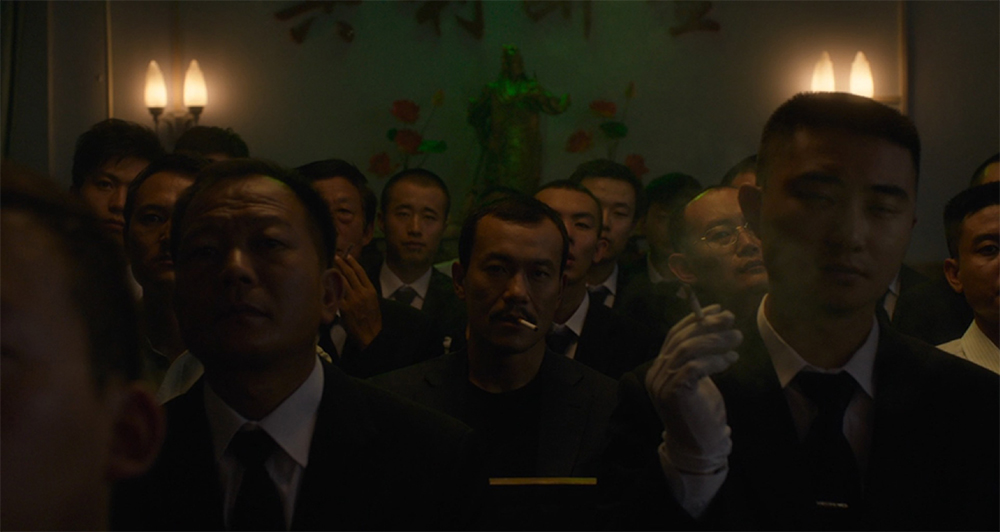
In contrast to the mass screen media that provoke competitive autonomy across the gangster community, popular theatre encourages an alternative subjectivity featuring attentive interactivity, which leads to Qiao’s acts of righteous love. As a participant audience of embodied performances, she finds her own subjective agency through live spectatorship and intersubjective event. In Act One, by observing and then joining the gangster world’s brotherhood ritual performances such as collective drinking and Lord Guan worshipping, Qiao has internalized the traditional ethic of yi (righteousness), which she adheres to despite Bin’s betrayal. Since the birth of her spectator subjectivity depends on audience participation, a sequence of dance performances in Act One switching between centrifugal chaos and centripetal order in terms of performance-audience relationship provides a revealing context for her subjectivity formation. The sequence begins with Qiao and Bin’s freestyle disco to the Village People’s “Y.M.C.A.” in a crowded dance hall. This signature scene in Jia’s cinema is democratic because disco has physically challenged the orthodox restriction on free individual expression in contemporary China.4 When the local big brother Eryong enters the discotheque, however, the liberal disco is interrupted by his favorite International Standard ballroom dance. Two professional sport dancers take the floor to demonstrate the mechanical precision of their body control while the others stand by to look silently with awe. Then the camera cuts to the exterior, a fenced square where a group of amateurs are dancing collective disco to “Y.M.C.A.” under the yearning gaze of a crowd of excluded onlookers, among whom stand the two young antiheroes from Unknown Pleasures. The recurring fence imagery in this dance sequence dramatizes the tension between regulation and rebellion, a perpetual tug of war between order and disorder, performer and spectator, which allegorizes the complex correlation between space politics, body kinetics, and subjectivity formation in post-socialist China (see Figures 3-6).
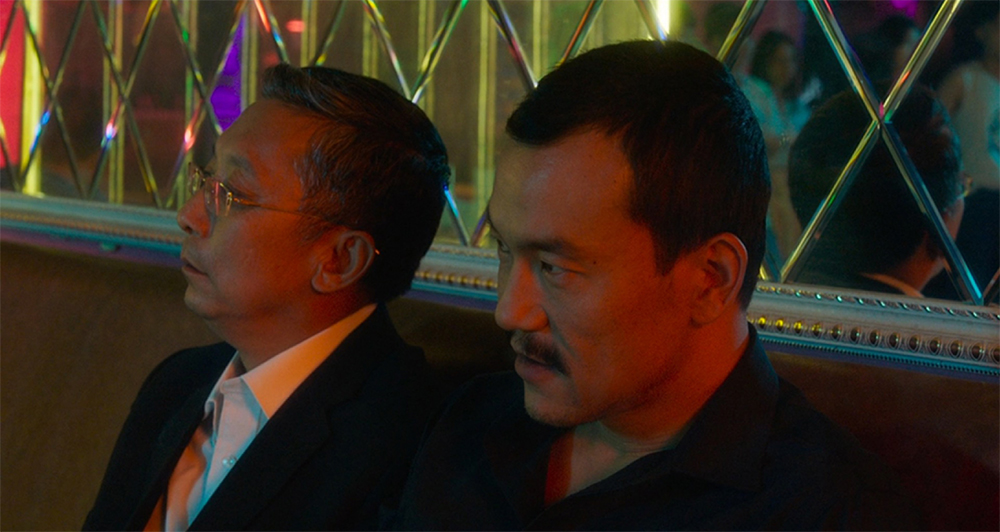
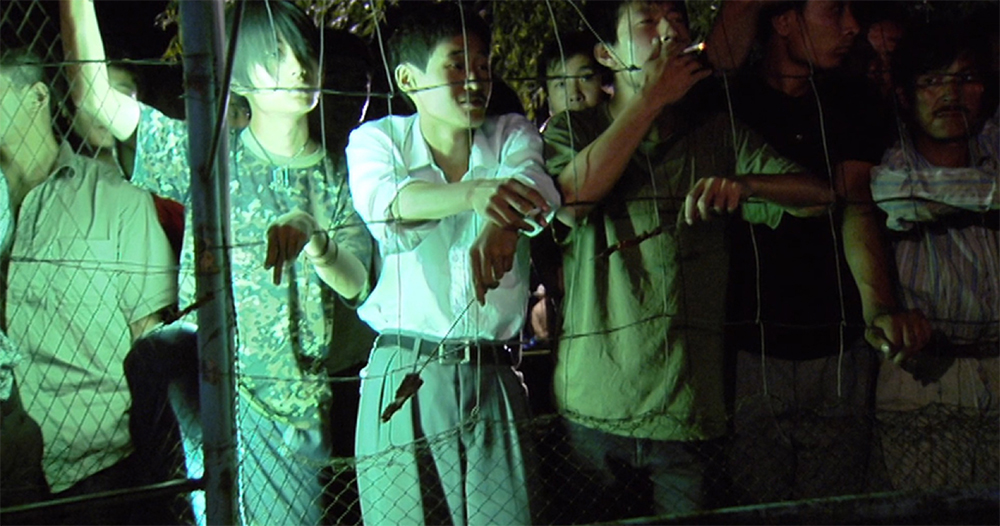
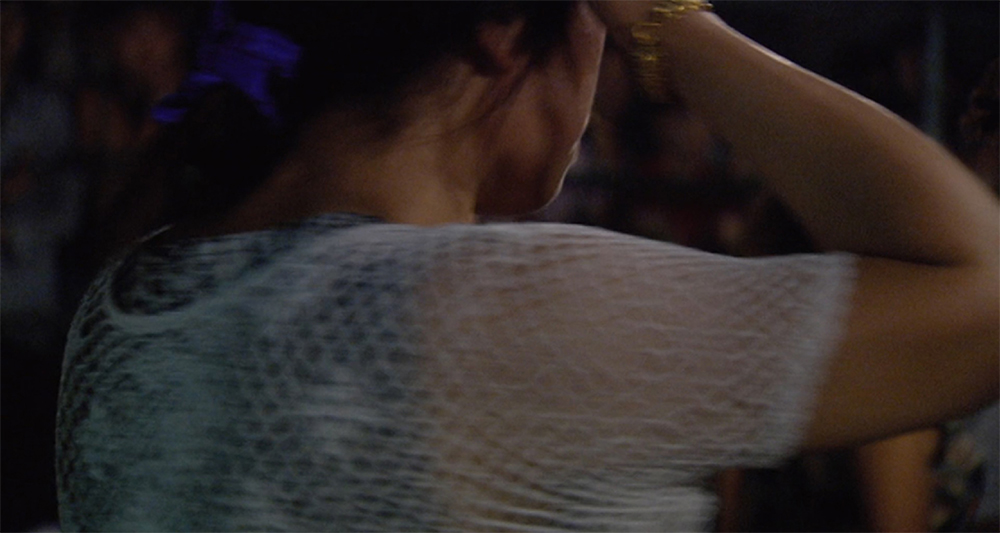

In Act Two, a pop music performance in street theatre propels Qiao’s subjectivity formation to the second stage. Informed of Bin’s betrayal a moment ago after five years of imprisonment, Qiao is roaming the streets of Fengjie when a pop singer of a travelling troupe suddenly kneels down before her and hands her an artificial red rose while bawling: “To what extent can love happen again?” Popular culture proffers an unexpected therapy for lost love. Later that night Qiao revisits the show in a theatrical venue in the new city of Fengjie, where a proscenium stage physically divides performers and spectators. But the communal instinct of pop culture inspires the singer to adapt his lyrics to the here and now while the camera switches to attentive faces in the packed auditorium. Invited to sing along, Qiao joins the chorus of strangers on and off the stage to raise the question: “When love has gone through a sea change, do I still have the courage to love?” After this communal sharing with strangers, Qiao is emotionally prepared to bid farewell to her traumatic past. The emancipated spectator is empowered by anonymous equality, which Jacques Rancière celebrates as a result of “unpredictable interplay of associations and dissociations” (17).
Lyrical Subjectivity: Intermedial Auteurism to Digital Pessimism
However, as the transfer from the fluid open space of street theatre to the fixed space of proscenium stage in the New Town Auditorium suggests, popular live performances are being systematically institutionalized to confirm hierarchical reality under the rhetoric of prosperity and harmony, so that emotional sharing alone may not lead to emancipated spectatorship. According to Rancière, “[t]he aesthetic community is a community of dis-identified persons. As such, it is political because political subjectivation proceeds via a process of dis-identification” (73). Ash is also trying to dis-identify its spectators by distancing itself from the immersive cinematic action and evoke an aesthetic community. Inspired by Immanuel Kant’s Critique of Judgment, Dennis J. Schmidt argues that the subject of aesthetic experience understands itself in lyrical rather than conceptual terms, which ultimately aims at an “otherwise inconceivable” ethical subjectivity (8). According to Peter V. Zima, literary scholars have also theorized on the “lyrical subjectivity” in modernist literature and discovered its oscillation “between the idealist illusion of omnipotence and its disintegration in society, psyche and language” (45). Ash follows this modernist tradition of “lyrical subjectivity,” but it also speaks to a “Chinese lyrical tradition” that counters the orthodox Chinese poetics of shiyanzhi (“poetry expresses what is intended in the mind”) (D. D. Wang 13). Focusing on heart rather than mind, the Chinese lyrical tradition has derived from a collective emotional perception of the cosmos as a kindred community and historical unity (Chang 524-5). One reaches the cosmic truth affectively through the shock and pain of individual human experience; for it is by “experiencing with one’s own life the world of eternal change” that one “immediately seiz[es] the inner aura of the cosmos to resist the all-exterminating time torrent and leave traces of one’s struggle for life” (Zong 299). Now that immediacy becomes ever more impossible in a media-saturated world, Ash approaches this “inner aura of the cosmos” or lyrical subjectivity through intermedial auteurism, before breaking the illusion of cinematic agency with a dose of digital pessimism.
For most of the film, Jia’s self-reflexive intermediality creates what Zima summarizes as the “idealist illusion of omnipotence” of the lyrical subject (45). An omniscient camera follows the heroine back and forth between two cities to witness the eclipse of social and ethical bonds in the process of speedy urbanization. Having professed his reverence for “all types of unknown things, god, ghost, heaven, the cosmos, aliens” (Z. Xu 2017), Jia occasionally takes a godlike perspectivation in Ash to make a cinematic comment on some transcendental power over human destiny. But his auteurist omniscience also reflects on its own medium-specific limitations by explicitly referencing other media or submedia. Critics have elaborated on how Jia’s visual aesthetic has been influenced by architecture, landscape painting, contemporary art, and popular music, and Cecília Mello rightly links his intermediality to Andre Bazin’s idea of “impurity” (9). As Dudley Andrew argues, Bazin emphasizes the notion of auteur “only as a tortion [torsion] in the knot of technology, film language, genre, cultural precedent and so forth, a knot that has in the past decades grown increasingly tangled” (78). Jia should be understood as a film auteur in this sense and his intermediality is a symptom of such “impurity.” But his intermediality in Ash not only evidences that “Jia’s cinema [is] capable of containing both the China of globalization and the China of millennial traditions” (Mello 9). Through the intermedial prism of documentary memory, aesthetic of ruins, and science fiction fantasy, Ash also embodies the auteur’s attempt at a lyrical omnipotence that emotionally connects the storyworld and the audience.
The film draws upon documentary memory by incorporating video footage the director captured from real life over the years, which affect the audience through shared historical, cultural, and personal memories. To accommodate the historical diversity of such archive footage in aspect ratio and image texture, French cinemaphotographer Eric Gautier shot the film with a variety of video cameras that Jia had used in the past ten years, ranging from low-resolution DV, 35mm film and underdeveloped 35mm, to HD and Ultra HD with increasingly higher resolution, including 2K, 4K, and 5-6K. The variety reminds the audiences that the changing video technology not only documents an era but also mediates personal memories of that era. The co-opted archival footage is not only documentary but also lyrical. The allegorical opening sequence, for example, shows rustic travelers caught in a traffic jam; confined to the bus seats, they can see little and do nothing except anxiously wait for a signal to proceed. The director has said about the “lyrical quality” of I Wish I Knew: “[A] film should also make an aesthetic contribution[;] it is a vehicle for expressing emotion.” (Zheng 119) The emotion aesthetically or lyrically expressed here is based on documentary memory. “[W]andering in any city in China,” the director writes in an article, “one can always see dismantling here and there and fast amnesia concurring with fast development”; so he makes films to “resist amnesia with the camera” (Jia, Jia Zhangke Speaks Out II 46). The archive footage in Ash, likewise, lyricizes the main narrative to resist a racing time of endless change.
When Qiao arrives in Fengjie in 2006, for instance, the Three Gorges area is in the heat of its massive hydroelectric project, which will ultimately raise the water of Yangtze River to 175 meters high and move more than one million people out of their hometown by the end of 2009 (Liang 1, 6). In an archival shot from that period, a tour guide’s voiceover informs tourists of the upcoming third-stage reservoir filling, which will raise the water level to 156 meters by September 2006 (see Figure 7). When Qiao arrives, therefore, the Kuimen Gate as the landmark of Fengjie has lost part of its original grandeur. As sightseeing tourists flux in to catch a final look at the original Three Gorges, replica images of the Kuimen Gate appear in all kinds of commercial spaces in the film, turning the vanishing landscape into a decorative simulacrum. The intermedial contrast between past and present laments that nothing is eternal in this abandoned city of sacrificed homes. Later in this act, the omniscient camera contemplates on emigrants at the wharf who are silently waiting to board a ship that is bound for some unknown land and uncertain future. Set to ambient space music, the serene portraits of these evicted people with their cherished pet animals, plants, and portable household objects lyrically register the dignity and tenacious hope of the dispossessed.
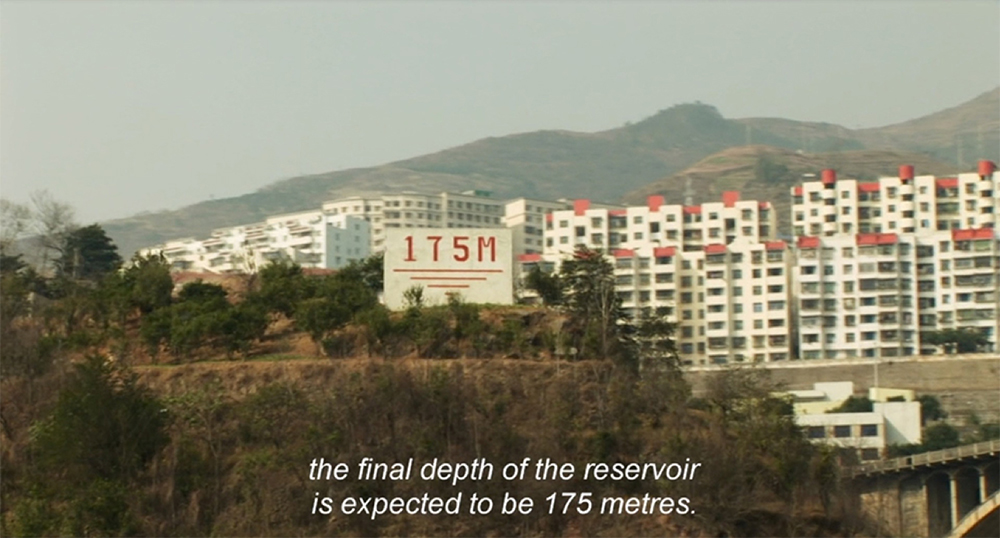
While some “only see how human nature is flooded by the ruins” (Li and Yan), Jia attempts to find embers of hope in this disappearing site of human wilderness. His cinematic Fengjie resembles the architectural ruins in Chinese art after the Sino-Japanese war and during the 1990s, which “opened up a didactic space between past and future [that featured] a commingled sense of ambiguity, openness and indeterminacy” (Wu 172-3, 203). Corey K. N. Schultz reads the ruin imagery in Jia’s pre-2008 films as a metaphor for destructed Maoism in the Reform era, which leads to “physical, emotional and temporal estrangements from a once-human space and an anticipated utopian future” (447, 456). What he misses is the lyrical hope in Jia’s films despite such uncertainty. The Datong volcano shows up twice in Ash to witness interpersonal emotional bond. In Act One, Bin despises this “ghostly place” where people are dying nameless death like “ashes of cannon fodder,” just like in 24 City (2008) memories of 30,000 workers plus their 100,000 families were “flicked away like ashes of a cigarette” to give way to a modern apartment complex development (Jia, “Preface” 3). In Act Three, however, an eye-to-eye conference with the volcano endows Qiao with the magical power to awaken Bin from his physical palsy, so that he miraculously rises from the wheelchair and walks towards her warm encouraging smile and beckoning hands. With the unmenacing volcano in this deep-focus shot quietly musing on the two human figures, Bin’s faltering steps and the gradually shortening distance between the estranged lovers are highly emotive with the gentle soundscape of space music, whooshing wind and rustling leaves (see Figure 8). As Qiao speculated seventeen years ago, after the ordeal of intensive burning “the volcanic ash must be the purest.” The film’s aesthetic of ruins lyrically intensifies this liminal hope after destruction.

Besides documentary archives and aesthetic ruins, science fiction is referenced in Ash as a fantastic source of hope. A chance meeting with UFO in Xinjiang prepares Qiao for a solitary venture into the unknown future. Unlike the surreal UFO scene in Still Life,which features illogical juxtaposition, the UFO in Ash is naturalized as something perceived by the heroine that provides her with a mysterious solace in her deepest solitude (Y. Zhang 2018). From various angles and distances, set to a mysterious but soothing soundtrack of space music, four consecutive shots represent the symbolic moment when Qiao stops by the desert on a dark night to look up into the gloomy sky as a UFO flies across overhead. This UFO sequence ends with a scenery shot of the slowly revolving starry sky, which glimmers with hope of the impossible world and indicates the director’s faith in the magic of cinema. After this passage rite, Qiao will emerge in the final act as a new woman, an independent subject-agent who mobilizes her own space (previously Bin’s gangster teahouse) to perform her own version of affective righteousness.
The nameless shopkeeper who has brought Qiao to Xinjiang is equally pivotal in bringing about this miracle. Designed to be a science fiction writer, he is the auteur’s self-portrait in disguise, a storyteller who dreams of transcending reality by tracking down the unknowable through a fictional project. This seemingly minor character enunciates the film’s most revealing punch line: “[W]e are all prisoners of the universe.” Though too timid to love a real prisoner, he brings on board a copy of UFO Exploration, a popular science magazine which since its first issue at the threshold of the Reform and Open-up Era in 1981 has inspired the explorative fantasy of a whole generation (see Figure 9). The popularity of this magazine also anticipated the rise of a science fiction new wave in China in the 1990s, partly encouraged by Hollywood sci-fi films and promoted mostly through online science-fiction fandom (Song, Science-Fiction 64-5). As Song Mingwei puts it, “[t]he new wave has unleashed a nightmarish unconscious of a dream that does not necessarily belong to an individual but rather to a collective entity” (“Introduction” xiii). Likewise, despite Qiao’s hopeful UFO sighting, Act Three of Ash conveys rather Jia’s digital pessimism and exposes what Zima calls the “disintegration [of lyrical subjectivity] in society, psyche and language” (45).

Set in 2017, Act Three represents a contemporary China where the mobile screen mediates individual link with the digital web. An online rumor about collective migration has portended the precarious nature of virtual utopia in Act One. Now in Act Three, when the homecoming Bin loses his direction in the transformed city, a mobile map with GPS tracking instantly locks on to him with cold schematic abstraction (see Figure 10). Then the close-up on the mobile screen in Bin’s gloved hand cuts to a bird-eye view of the estranged cityscape. Tilting while panning, as if to simulate the movement of the earth, the camerawork shows a half sunlit, half shadowed city in its constant counterclockwise rotation. A panoramic overview of the same city in 2001 presents a chaotic jumble of skyscrapers in the background, an ancient temple complex in the midground, and old buildings under demolition in the foreground. The temporal contrast in topography manifests the invisibility of individual lives despite their participation in this great drama of vicissitude and change.

The digital web has transformed the present-day gang world as well. A mobile phone replaces the illegal gun when a discontented former underling takes his revenge by broadcasting the wheelchaired image of Bin to make his downfall a laughing stock. When Bin reacts by taking up a bet on his indispensable wheelchair, many more switch on their webcams to scandalize this scene. Online sharing, Jia has argued, might lead to nothing but “an illusion of information” and a monist value system if not based on individual agency (Jia Zhangke Speaks Out II 189). According to a parody paper he wrote to express his cosmological view, human beings today have lost the divine ability “to understand and communicate with the most sensitive information of the universe,” whereas technologies from radio to digital information constitute “nothing but the fog between humanity and the universe” (Z. Xu 2017). Bin’s selfie in the traditional Chinese clinic also translates the auteur’s suspicion of media technology. Cornered to the lower left side of the screen, with a cigarette in his mouth and dozens of acupuncture needles into his head, the digital portrait captures Bin’s pent-up face with a ridiculous low angle close-up distortion (see Figure 11). This recognition moment predicts Bin’s illusion-breaking departure near the end of the film.
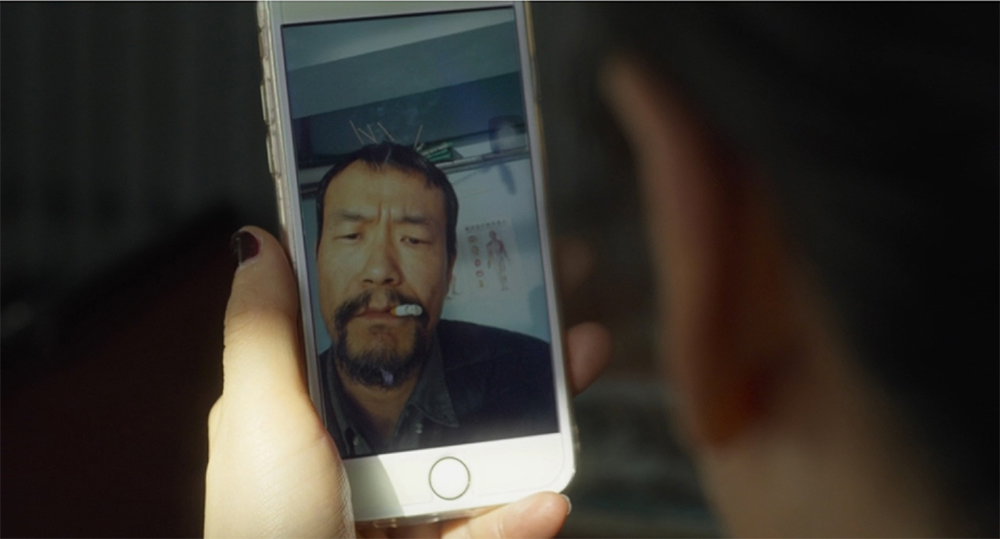
Just when the audiences start to expect a happy ending after Bin’s miraculous recovering, the runaway hero penetrates the screen and throws the gaze of spectators back to themselves. Like the little child who suddenly awakes and stares into the video camera in the opening sequence, in Act One Bin has stared into the eyes of the audience before turning aside to release the bullet when he teaches Qiao how to fire a gun. That provocative in-your-face moment, though brief, anticipates Bin’s Brechtian gaze upon his departure in Act Three. When the news broadcast from Voice of China officially sets the time at 7:00 AM on 1 January 2018, Bin walks with a cane into the corridor and, before plodding out of sight, sharply turns his head toward the audience and glares into their eyes for more than 7 seconds (see Figure 12). Then his voice message “Gone” comes in curtly through Qiao’s mobile screen. Played twice, the mediatized reproducible voice ironizes his physical absence to resonate with her solitude. Bin’s abrupt leaving has led many to question his moral accountability, but that farewell stare drills into the digital void behind the camera and raises self-reflexive doubts within an empathetic spectator.

At the end of the film, an apathetic surveillance camera mysteriously competes with the filmmaking camera and its empathetic lyricism to reveal the heroine and her old-fashioned teahouse as physically and mentally imprisoned in time. The surveillance camera system has been installed under Qiao’s pondering supervision and the monitor screen is located in Bin’s provisional bedroom. After Bin’s departure, the filmmaking camera follows Qiao to stomp out of the gate and look into the street, then suddenly switches to a close-up on the monitor screen, which juxtaposes moving images of various spaces in and outside the house, each as a fixed, disinterested long take. When one of the monitor images shows Qiao come back in with frustration and lean against the corridor wall, the filmmaking camera zooms in to blow up a high angle medium-shot taken by a surveillance camera that gazes obliquely at her now wishy-washy indistinct figure (see Figure 13). This closing sequence alludes to the ubiquitous surveillance in urban China today, which digitalizes the pervasive structure of power over individual subjectivity. But the message is not as simple as political dichotomy, for each individual may have participated in the system as well and therefore is simultaneously the surveillant and the surveilled. The camera of the cosmos is incessantly developing images of human beings as “prisoners of the universe” while concomitantly erasing them. Even this film per se and film as an art form, warns the intermedial closing sequence, may sooner or later pass into oblivion despite all the dreams and struggles. When the surveillance image suddenly appears and competes with the filmmaking camera to exhibit the futility of subjective agency and the improbability of companionship, it throws the whole film in retrospect and questions the film auteur’s storytelling project.
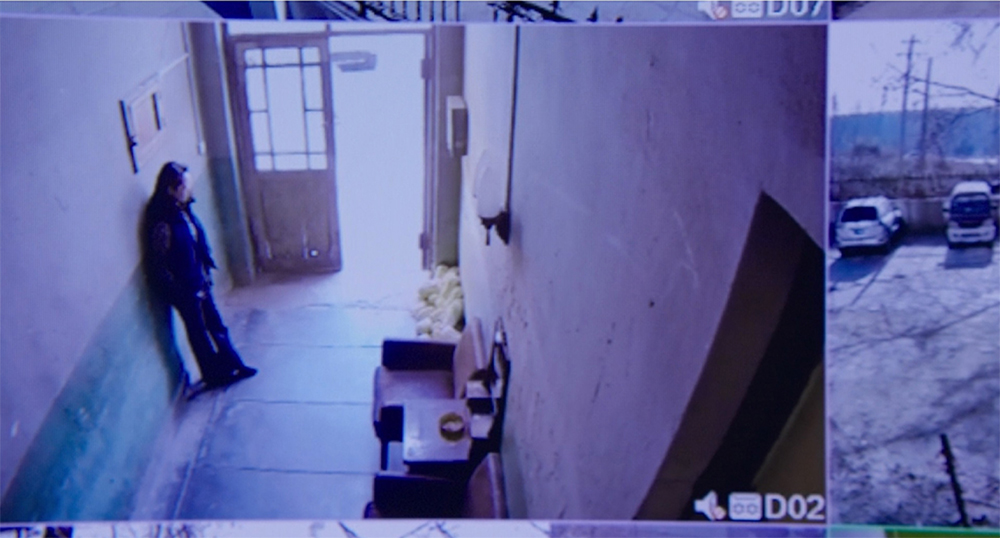
Elsewhere Jia has written about our existential quandary citing Journey to the West: “The Monkey King can fly tens of thousands of miles with one somersault, so that it looks like he is free in time and space. But in the end he cannot escape the palm of the Buddha” (Jia Zhangke Speaks Out 115). Realizing that human beings are born to be unfree, he insists on making pessimistic films: “Pessimism will give us a pragmatic spirit; it is our approach to freedom” (116). The ending of Ash therefore reveals yet another meaning of jianghu. The ancient Daoist philosopher Zhuangzi has used this term to explain his ideal world where the moral distinction between good and evil is irrelevant so that one can forget about moral judgement and just “transform [oneself] with the Way” (Zhuangzi 44). This mystic message has since recurred in Chinese literature and even Chinese cinema, such as the Buddhist ending of King Hu’s A Touch of Zen (1971) and the Daoist ending of Ang Lee’s Crouching Tiger, Hidden Dragon (2000). Aesthetically more self-reflexive, the intermedial final sequence of Ash turns the filmmaking camera back on itself and dramatizes its wrestle with an inhumane cosmic eye that “regard[s] the ten thousand things [including people] as straw dogs” (Laozi 15). Aiming to shock the viewer in the dark into realizing that the non-differential surveillance image will sooner or later be deleted, that the tragedy of Qiao and Bin is being watched as a digital illusion but empathized and experienced by an aesthetic community of dis-identified individual spectators, this temporary but lyrically subjective sharing of emotion between the auteur and the audience in virtual reality may, hopefully, make all the difference.
Transmedia World Building: Authorship and Audience Participation
In actual reality, after its public release in mainland China in September 2018, the audience responses to Ash have been divided. Jia’s popular turn is partly a proactive response to the influx of Hollywood movies into the post-WTO Chinese film market. As Victor Fan recently argues, the Chinese film market exists “not as a conceptually and historically stable space or network of exchanges, but rather as a set of problematics and a constantly changing medium that has been complicated by the People’s Republic of China’s (PRC) postsocialist conditions” (“What Is” 303). Fan distinguishes the state-sanctioned film market from the independent marketplace as two opposite modes of bare-life existence for Chinese filmmakers today (308), but many filmmakers negotiate with both and work in the vastly diverse middle area in between. Despite his major focus on the independent works, therefore, at the end of his article Fan admits without elaboration that the state-sanctioned filmmakers “in their own way also strive to become independent from the law-in-force, so that their own creativity and profit can be maximized” (310). Jia’s Ash is an example in this regard. As discussed above, his generic films consciously narrate an increasingly personalized cultural history of China’s transformation into a media-saturated society, which is psychologically and emotionally intertwined with the economic change and sociopolitical reality in post-WTO China.
This auteurist genre approach is based on Jia’s acquaintance with both popular and avant-garde traditions of world cinema and their historical contour in Chinese cinema. As he has explained in an interview, socialist literature and arts before the Reform era rejected individualization while trumpeting popularization, which in those years meant to “convey the mission of the Communist Party to the uneducated masses” (Zheng 112). It was not until the 1980s that film auteurs reemerged in China and not until the early 21st century that commercial genre films started to take over Chinese film industry, led by the “fifth-generation” auteur-turned-blockbuster filmmakers such as Zhang Yimou and Chen Kaige. In 2003, the underground “sixth-generation” directors also reached some agreement with China’s Film Bureau and “formally returned to the Chinese film market regime and cultural recognition system” (Nie 90). With these filmmakers collectively, if sometimes reluctantly, turning to genre filmmaking and with the state’s severer crackdown on the independent film scene in the past decade, critics have asked: “Is independent cinema in China dead?” (Berry 2017). If, as Victor Fan has argued, in the Chinese context “the idea of the cinematic auteur cannot be divorced from the dual meaning of being ‘independent’” (“Revisiting Jia” 323), one may well have asked: “Is auteur film in China dead?”. Jia’s three features after his popular turn have provided a negative answer. These films intend to negotiate with the state regulation of Chinese film market, neither denying nor yielding to the non-auteurist elements now incorporated into his work. The genre storytelling in Ash is a strategic move forward in his auteurist world building project.
The ambiguous ending of Ash opens up a new opportunity for transmedia world building, where audience participation comes in through Internet connection. Henry Jenkins has argued in his book Convergence Culture (2006) that transmedia storytelling ideally “unfolds across multiple media platforms, with each new text making a distinctive and valuable [medium-specific] contribution to the whole” (95-6). Ash is not a case of transmedia storytelling in this sense, but it shows the potential of an auteur director’s genre film for transmedia world building by inspiring vigorous audience participation on Chinese social media such as Sina Weibo (a microblog service) and video sharing platforms such as Douyin (Chinese version of Tik Tok) and Bilibili. Convergence culture has impacted sociopolitical reality and film industry in post-WTO China and led to a phenomenon even more complicated than the “global convergence” in Jenkin’s analysis.5 The reception of Ash exemplifies this complexity and further complicates the issue of authorship in Jia’s recent genre filmmaking. His active transmedia marketing efforts and the Chinese netizens’ polarized online responses, often linked to their engagement with his previous works, illustrate the potential as well as problem in terms of political efficacy of the art cinema auteur’s transmedial world building.
A typical thumbs-down social-media response to Ash upon its public screening around China in 2018 was written by Hu Xijin, editor-in-chief of the semiofficial newspaper Globe Times. His short taunting review was posted on Sina Weibo, where both Hu and Jia have millions of followers. Dismissing Ash as “a mediocre story told through a dark lens about good people getting no reward,” Hu lectured Chinese filmmakers like Jia that they should “learn from Hollywood and Bollywood to make films with a normal vison of good and bad, and stop poking a stinky bean curd under the nose of the masses and forcing us to accommodate and enjoy the peculiar stink.” Hu deleted the post after Jia reacted with a restrained yet no less taunting rebuttal, which was forwarded more than 61,000 times and supported by 127,000 likes. On 13 February 2019, however, Hu published another Weibo post to praise two films “celebrating positive energy,” namely Wolf Warrior 2 (2017) and Wandering Earth (2019). “Those ‘art films’ with negative energy,” he claimed, “are destined to be minority and cater only to some people’s negative emotions.” The differences between Ash and the two emulated “positive” films, with “Hollywood and Bollywood” as a yardstick, are evident enough to trouble a “main-melody” media warrior like Hu. In his analysis of the phenomenal box-office success of Wolf Warrior 2, Stephen Teo astutely observes that the film, with its individualist hero and Maoist propaganda, provides “a crucial model for Chinese cinema’s integration of its own form of heroic genre cinema with the more established conventions of Hollywood cinema as the Chinese industry tries to expand and spread its wings throughout the world” (322-23). This model is followed by The Wandering Earth, which rewrites Liu Cixin’s apocalyptical science fiction into a Hollywoodish story about Chinese heroes saving the world.
Notably, Hu resorted to a discourse about generation gap to explain the difference between such new mega productions and art films like Ash. “The majority of today’s film audiences were born in the 1990s or after, who have witnessed the revival of China and been edified by a time different from that of Jia Zhangke and his ilk,” he bluntly asserted. The demographic change does play a significant role in the mediatized culture war arena of the post-WTO China. As Paul Clark points out, with sanction from the state, by 2008 some Internet nationalism had emerged despite the “apparent popular globalisation” of China’s youth culture (3). But Hu’s derision also harkens back to the familiar charge that the “sixth-generation” directors including Jia used to face in their own youthful underground years. The “patriarchal mindset” (Jia, Jia Zhangke Speaks Out 116) that used to silence the discontent of young artists is now celebrated by Hu as the new zeitgeist of younger generations, with the patriarchal demand for positivity now identified as “the basic value of Confucianism, which is the dominant thought of Chinese civilization” (Hu 2019). This identification reveals the ascending role of Confucianism as a handy cohesion to reconcile the Marxist rhetoric and neoliberalist ideology of the deeply divided post-WTO China. Although the history of 20th-century Chinese culture featured a “de-Sinicization” process (H. Zhang, “Five Controversies” 117), Confucianism has remarkably revived in the 21st century with the help of new mass media (Chen 85). Now legitimized as the “cultural meme of Chinese people” (Wu 2014), Confucianism once again overshadows its historical rival Daoism that breeds Jia’s negativity. With its bent for “nothingness, stillness, and emptiness” (H. Zhang, “How Zhuangzi” 94), this Daoist negativity may inspire a youthful counterculture movement as it did among the American beat generation through its influence on writers such as Jack Kerouac.6 To some extent, modern China was created by youth culture when a generation of young intellectuals initiated a New Culture movement against the dominant Confucian value system in the early twentieth century. A century later, will the revival of Confucianism encouraged by the state appeal to the post-WTO Chinese youth and decide the future of China as a nation-state? The ideological debate is again focused on a fight to engage the younger generation, this time the Chinese iGeneration of the Internet age.
In China’s iGeneration, a seminal collection of essays on China’s new filmmaking in the digital age, Luke Vulpiani argues that Jia’s 24 City and Lou Ye’s Summer Palace (2006) signaled a transition in Chinese cinema toward iGeneration filmmaking (89). Despite his digital pessimism, Jia does share the iGeneration’s passion for digital filmmaking technology and openness to new digital media. The marketing of Ash featured youth-oriented online campaigns including promotional songs created by young popular singers, and a video autobiographical duet from the director and a young talent show celebrity respectively that juxtaposes their personal memories about one’s journey from hometown to jianghu. After the release of Ash through both movie theatre screening and online streaming, audiences respond to the film by writing fan criticism, creating fan fiction, circulating promotional songs, making fan music videos, among other means of participation. Via his personal Weibo account, the director frequently interacts with the audiences and encourages creative audience participation by forwarding and commenting on their posts. Inspired by some audiences’ playful imitation of the gangsters’ brotherhood ritual of drinking in Ash, for instance, the director elicited a collection of 26 (A-Z) audience performances based on the film’s trailer or his previously works. Most of his keenly interactive fans on social media are iGeneration audiences, who not only get used to but also initiate new modes of cinema consumption.
These online interactions are typical of convergence culture, “a paradigm shift” according to Henry Jenkins, the democratic potential of which lies in “whether the public is ready to push for greater participation or willing to settle for the same old relations to mass media” (243). But even Jenkins agrees that “the most successful transmedia franchises have emerged when a single creator or creative unit maintains control” (106). The result may not be traditional auteurism, but what Suzanne Scott describes as “an evolving vision of the contemporary auteur that thrives within tensions between the commercial and the subcultural, the mass and the niche, the recognizable and the intertextual” (456). Jia’s transmedia interaction with younger audiences shows his attempt at finding a balance between his auteurism and audience participation. So far, this transmedia interaction has strengthened rather than challenged his individual authorship. By adapting to the convergence culture, the director has constructed a popular transmedia auteur image of himself through literary and cinematic writings, interviews and dialogues on his own works, lecture podcasts on film theory, two filmmaking schools including the recently launched Shanxi Film Academy, and a business chain in his hometown Shanxi Province that includes a theme restaurant named after Mountains May Depart, two movie theatres and a film bookstore. He initiated a social media-based platform Ke Premiere to introduce short films from around the world in 2016, and then co-founded the annual Pingyao International Film Festival with Marco Muller in 2017, the latter aiming partly to introduce the diversity of world cinema, which is often neglected despite the bloom of movie theatres and online video platforms in China, and partly to support young Chinese filmmakers who make experimental movies that are more likely to meet financing problems (Jia, Interview).7 Jia’s transmedial cultural influence has been wide-spread enough for him to be elected a deputy to the National People’s Congress in 2018. While some criticize his election as a compromise with political authorities, the pragmatic auteur takes it as a chance to speak for the marginalized and further his world building project across cinematic art and complex social reality (Jia, “To Continue”).
But any cultural influence inevitably smacks of prestigious cultural capital in an authoritarian neoliberalist system. The audience participation in response to Ash is still far from truly democratic, and collaborative authorship is an emerging but distant horizon in the auteur’s recent transmedia world building efforts. So the questions remain: is it truly possible for an arthouse auteur to reach the general public with his social critique and philosophical vision through transmedia world building? In a heavily regulated and bitterly polarized Internet environment, is it possible to find some common ground and reach some level of consensus based on aesthetic sharing? And even if total Internet freedom is granted, will convergence culture truly advance democracy and optimize political participation? The director himself is not unaware of such challenges. In A Touch of Sin, when the middle-aged owner of a strip club turns around to face the audience, we find he is no other but the director himself with a Hitchcockian cigar. Not only an auteur signature, the cameo performance contrasts sharply with Jia’s debut screen performance as a blasphemous young migrant worker in his first feature Xiaoshan Going Home (see Figures 14-15). Jia’s social status and artistic profile have certainly escalated since then, and he is mocking himself with this deprecating caricature in A Touch of Sin. The youngsters laboring in that club try to connect with the outside world through an iPad, a patronizing gift from the ostentatious boss, but they have nothing to say but a repetitive curse to the numerous online reports about official corruption and public disaster, things they grudge but cannot change in their own plight. The spontaneous diversity of online audience responses to Ash marks the beginning of Jia’s interactive world building project, but there is still a long way to go before the audience can truly participate in the auteur’s transmedia world on an equal footing and effect change in real life.
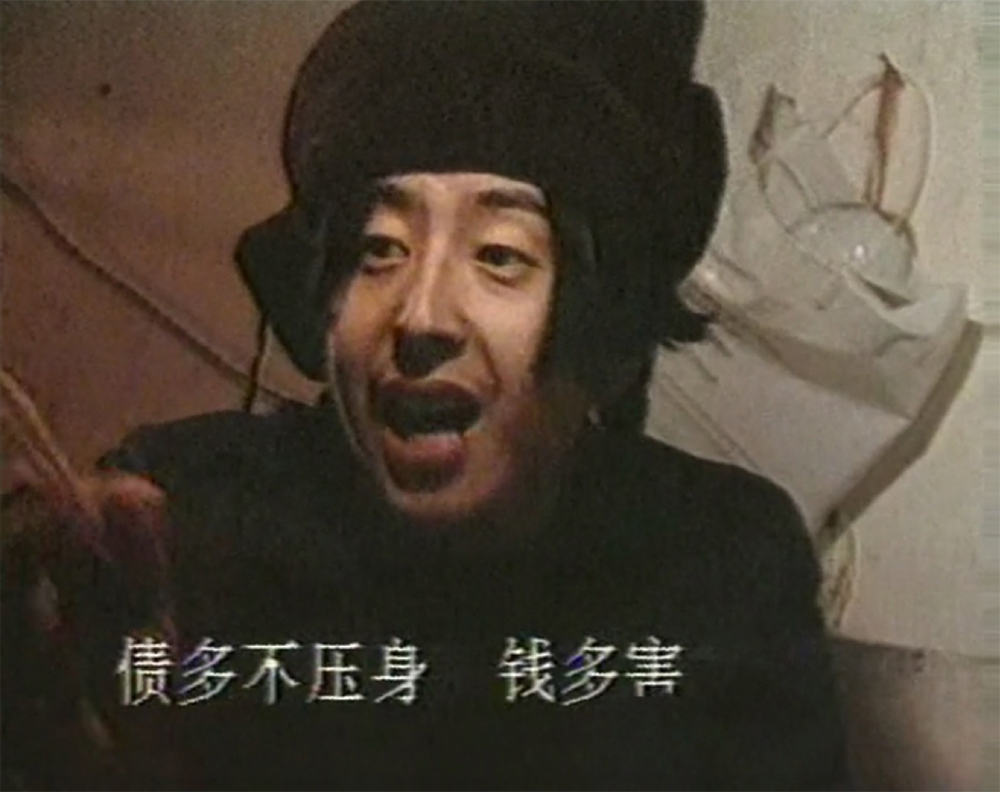
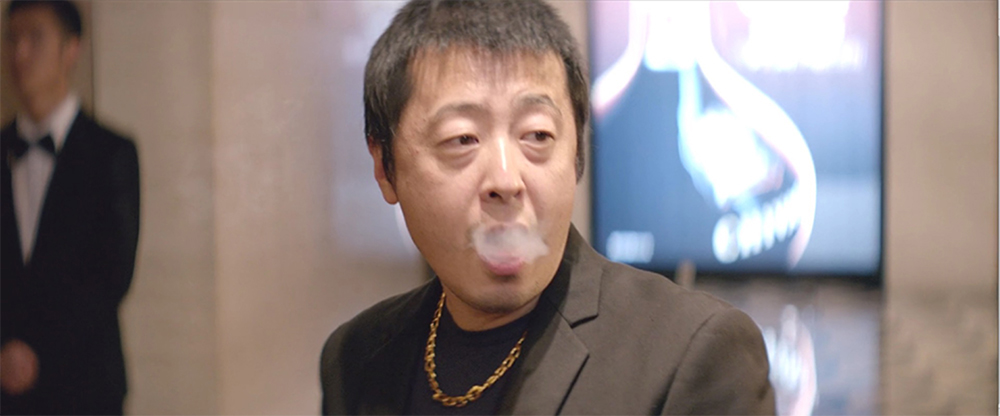
All that said, Jia’s complete oeuvre is an evolving and ever more self-conscious world building project while Ash is an indispensable building block in that world, which reflects on that world by means of media transformation. Through transmediation, it creates an auteurist genre hybrid; through media representation, it probes into the significant role media play in generating two types of spectator subjectivity, respectively competitive autonomy and attentive interactivity. But a lyrical subjectivity subverted both, consciously undermining Jia’s intermedial auteurism with his digital pessimism. As a self-reflexive work in the age of media convergence, Ash also inspires transmedia audience participation so that Jia’s world building project not only travels between fiction and reality, across media old and new, but also back and forth between the auteur and the audience. The ongoing process is unpredictable and often frustrated, but always sustained by some pessimistic hope. At the end of Ash, just when the surveillance image and the noise of electric current seem to wash away Qiao’s individual identity, throbbing drumbeats begin to rise in crescendo before a total blackout. The menacing sound suggests some unknown mysterious force, but it is also the dynamic rhythm that has driven Qiao’s vibrant kinetics from the very beginning; it externalizes the blood, heart, and mind of this growing woman at every critical moment. When the familiar alarm strikes again at the end of the film, most likely, she will break the deadlock and push open another door. The same is true with Jia’s world building project, which is yet open to change as media keep changing reality and transforming his film aesthetic. The auteur has frankly admitted that the so-called “sixth-generation” Chinese cinema as a film movement has diversified; but, in defense of this “inconvenient” generation, he declares: “I don’t believe you can figure out how we will end” (Jia Zhangke Speaks Out II 119, 122).
Endnotes
1 Jianghu and xiake are inseparable in the minds of Chinese readers, argues Chen Pingyuan, which “involves the youxia spirit as a product of Chinese culture and wuxia novels as a basic form of Chinese novel.” See Chen Pingyuan, p. 159.
2 See Henry Jenkins, p. 113.
3 According to Kin-Yan Szeto, Woo’s The Killer combines American gangster movie with xia (chivalry) heroes from Chinese martial arts films to create “a new version of xia in the city.” See Kin-Yan Szeto, pp. 75-6.
4 See Xu Min, pp. 8-12.
5 In his book Convergence Culture, Jenkins describes the transnational production and reception of Ang Lee’s Crouching Tiger, Hidden Dragon as one of the “examples of corporate hybridity, which depend on consumers with the kinds of cultural competencies that could only originate in the context of global convergence, requiring not simply knowledge of Asian popular culture but an understanding of its similarities and differences with parallel traditions in the West.” See Jenkins, p. 112.
6 For the influence of Daoism on Karouac, see Chandarlapaty, p. 132.
7 According to an unexpected announcement the director made at the end of the 4th Pingyao festival in October 2020, the festival will be handed over to the local government. He did not explain why, but this may be yet another case of the complicated ongoing negotiation between the auteur director and the political as well as economic forces in contemporary China.
Works Cited
Andrew, Dudley. “The Absent Subject of The World.” Journal of Chinese Cinemas 12.1 (2018): 59-73.
---. “The Unauthorized Auteur Today.” Film Theory Goes to the Movies: Cultural Analysis of Contemporary Film. Ed. Jim Collins, Hilary Radner and Ava Preacher Collins. London and New York: Routledge, 1993. 77-85.
Berry, Chris. “The Death of Chinese Independent Cinema?” China Film Insider 9 November 2017. Accessed 16 April 2020. http://chinafilminsider.com/the-death-of-chinese-independent-cinema/.
Bolter, Jay David, and Richard Grusin. Remediation: Understanding New Media. Cambridge, MA: MIT Press, 2000.
Chandarlapaty, Raj. The Beat Generation and Counterculture: Paul Bowles, William S. Burroughs, Jack Kerouac. New York: Peter Lang, 2009.
Chang, Shu-hsing. “The Ontological Awareness of Lyrical Tradition: Reading ‘Preface to The Lanting Poetry Collection’ via the ‘Performance’ of Theory.” The Modernity of Lyricism: Essays on Chinese Lyrical Tradition. Ed. Leonard K. K. Chan and David Der-wei Wang. Beijing: SDX Joint Publishing Company, 2014. 522-39.
Chen, Bisheng. “An Overview of the ‘Sinology Fever’ in Mainland China in the Past Decade.” Beijing Cultural Review 2 (2010): 82-7.
Chen, Pingyuan. The Development of Chinese Martial Arts Fiction. Trans. Victor Petersen. Cambridge: Cambridge University Press, 2010.
Chow, Rey. “China as Documentary: Some Basic Questions (Inspired by Michelangelo Antonioni and Jia Zhangke).” The Poetics of Chinese Cinema. Ed. Gary Bettinson and James Udden. New York: Palgrave Macmillan, 2016. 185-202.
Clark, Paul. Youth Culture in China: From Red Guards to Netizens. New York: Cambridge University Press, 2012.
Elleström, Lars. Introduction. Beyond Media Borders. Vol. 1. Ed. Lars Elleström. Cham, Switzerland: Palgrave Macmillan, 2020.
---. “Transmediation: Some Theoretical Considerations.” Transmediations: Communication across Media Borders. Ed. Niklas Salmose and Lars Elleström. New York and London: Routledge, 2020. 1-14.
Fan, Victor. “Revisiting Jia Zhangke: Individuality, Subjectivity, and Autonomy in Contemporary Chinese Independent Cinema.” The Global Auteur: The Politics of Authorship in 21st Century Cinema. Ed. Seung-hoon Jeong and Jeremi Szaniawski. New York and London: Bloomsbury Academic, 2016. 323-42.
---. “What Is a ‘Chinese Film Market’?” Screen 60.2 (2019): 303-10.
Gautier, Eric. “Cinematographer Eric Gautier, AFC, Discusses His Work on Jia Zhang-ke’s Film Ash Is Purest White.” Afcinema 13 May 2018. Accessed 13 June 2020. https://www.afcinema.com/Cinematographer-Eric-Gautier-AFC-discusses-his-work-on-Jia-Zhang-ke-s-film-Ash-Is-Purest-White.html?lang=fr.
Holtmeier, Matthew A. “The Wanderings of Jia Zhangke: Pre-hodological Space and Aimless Youths in Xiao Wu and Unknown Pleasures.” Journal of Chinese Cinemas 8.2 (2014): 148-59.
Hu, Xijin. @Hu Xijin, Sina Weibo, 24 September 2018, 0:18 a.m. Accessed 24 September 2018. weibo.com/huxijin?refer_flag=1005055013_.
---. @Hu Xijin, Sina Weibo, 13 February 2019, 1:51 p.m. Accessed 16 February 2019. weibo.com/huxijin?refer_flag=1005055013_.
Hui, Calvin. “Dirty Fashion: Ma Ke’s Fashion ‘Useless’, Jia Zhangke’s Documentary Useless and Cognitive Mapping.” Journal of Chinese Cinemas 9.3 (2015): 253-70.
Jenkins, Henry. Convergence Culture: Where Old and New Media Collide. New York: New York University Press, 2006.
Jia, Zhangke. @Jia Zhangke, Sina Weibo, 25 September 2018, 11:48 p.m. Accessed 26 September 2018. weibo.com/jiazhangke?profile_ftype=1&is_all=1#_0.
---. Interview with Peter Cowie. “Chinese Director Jia Zhang-Ke on His Latest Documentary/Berlinale Talents 2020.” YouTube, uploaded by Berlinale-Berlin International Film Festival, 24 February 2020. Accessed 1 August 2020. https://www.youtube.com/watch?v=K3SHxcU7PNw.
---. Jia Zhangke Speaks Out: The Chinese Director’s Texts on Film, 1996-2008. Beijing: Peking University Press, 2009.
---. Jia Zhangke Speaks Out II: The Chinese Director’s Texts on Film, 2008-2016. Beijing: Taihai Publishing House, 2017.
---. “Jia Zhangke Talks about Ash Is Purest White.” Aiqiyi, uploaded by Global People Magazine, 22 August 2018. Accessed 13 February 2020. https://www.iqiyi.com/v_19rr58a6eg.html#curid=1353485700_95beedde48f5f768111e4ba4dd52afd5.
---. “Lecture Six: Author in Genre.” I Only Know One or Two Things about Film. Vistopia, 20 May 2020. Accessed 12 July 2020. Podcast.
---. “Preface: The Rest Is Silence.” A Collective Memory of Chinese Working Class. Jinan: Shandong Pictorial Publishing House, 2009. 1-6.
---. “To Continue My Thinking in Film as a Deputy to the National People’s Congress.” Baijiahao, uploaded by China National Radio, 7 March 2019, 10:28 p.m. Accessed 9 July 2020. https://baijiahao.baidu.com/s?id=1627357376250091802&wfr=spider&for=pc.
Laozi. Daodejing: The New, Highly Readable Translation of the Life-Changing Ancient Scripture Formerly Known as the Tao Te Ching. Trans. Hans-Georg Moeller. Peru, IL: Open Court, 2007.
Li, Yifan, and Yan Yu. “Directors’ Words on Before the Flood.” 99ys.com, 4 April 2012. Accessed 6 May 2019. http://news.99ys.com/index.php?m=content&c=index&a=app_view&id=84953.
Liang, Fuqing. On the Migration Issues of the Three Gorges Project. Wuhan: Huazhong University of Science and Technology Press, 2011.
Liang, Zhenqiao, Li Zhi, and Ding Congming. “An Empirical Study of the Laid-off Workers from State-owned Enterprises and Crime Rate.” World Economic Literature 1 (2018): 22-43.
Lu, Xun. A Brief History of Chinese Novels. The Complete Works of Lu Xun. Vol. 9. Beijing: People’s Literature Publishing House, 2005. 1-350.
McLuhan, Marshall. Understanding Media: The Extensions of Man. London: MIT Press, 1994.
Mello, Cecília. The Cinema of Jia Zhangke: Realism and Memory in Chinese Film. London: Bloomsbury Academic, 2019.
Nie, Wei. “The Entropy Change of a Concept: The Genesis, Transformation, and Dissipation of the ‘Sixth-generation’ Cinema.” Literature and Art Studies 2 (2012): 88-97.
Rancière, Jacques. The Emancipated Spectator. Trans. Gregory Elliott. London and New York: Verso, 2009.
Schmidt, Dennis J. Lyrical and Ethical Subjects: Essays on the Periphery of the Word, Freedom, and History. New York: State University of New York, 2005.
Schultz, Corey Kai Nelson. “Ruin in the Films of Jia Zhangke.” Visual Communication 15.4 (2016): 439-60.
Scott, Suzanne. “Dawn of the Undead Author: Fanboy Auteurism and Zack.” A Companion to Media Authorship. Ed. Jonathan Gray and Derek Johnson. Malden, MA: Wiley-Blackwell, 2013. 440-62.
Sobchac, Vivian. The Address of the Eye: A Phenomenology of Film Experience. Princeton, NJ: Princeton University Press, 1992.
Song, Mingwei. “Introduction: Does Science Fiction Dream of a Chinese New Wave?” The Reincarnated Giant: Twenty-first Century Chinese Science Fiction. Ed. Mingwei Song and Theodore Huters. New York: Columbia University Press, 2018. xi-xxi.
---. Science-Fiction New Wave in China: History, Poetics, Text. Shanghai: Shanghai Literature and Art Publishing House, 2020.
Szeto, Kin-Yan. The Martial Arts Cinema of the Chinese Diaspora: Ang Lee, John Woo, and Jackie Chan in Hollywood. Carbondale and Edwardsville: Southern Illinois University Press, 2011.
Teo, Stephen. “The Chinese Film Market and the Wolf Warrior 2 Phenomenon.” Screen 60.2 (2019): 322-31.
---. Chinese Martial Arts Cinema: The Wuxia Tradition. Edinburgh: Edinburgh University Press, 2009.
---. “Chinese Melodrama.” Traditions in World Cinema. Ed. Linda Badley, R. Barton Palmer and Steven Jay Schneider. Edinburgh: Edinburgh University Press, 2006. 203-13.
Vulpiani, Luke. “Goodbye to the Grim Real, Hello to What Comes Next: The Moment of Passage from the Sixth Generation to the iGeneration.” China’s iGeneration: Cinema and Moving Image Culture for the Twenty-first Century. Ed. Matthew D. Johnson, Keith B. Wagner, Tianqi Yu and Luke Vulpiar. New York and London: Bloomsbury, 2014. 89-103.
Wang, David Der-wei. The Lyrical in Epic Time: Modern Chinese Intellectuals and Artists through the 1949 Crisis. New York: Columbia University Press, 2015.
Wei, Shang. “The Literati Era and Its Demise (1723-1840).” The Cambridge History of Chinese Literature. Ed. Kang-i Sun Chang and Stephen Owen. Cambridge: Cambridge University Press, 2010. 245-342.
Wu, Hung. A Story of Ruins: Presence and Absence in Chinese Art and Visual Culture. London: Reaktion Books, 2012.
Wu, Tianwen. “Xi Jinping Advocates ‘Setting the Ancient Classics in the Minds of Students’ as Orientation for Educational Reform.” The People’s Network: The Communist Party of China News Network, 11 September 2014. Accessed 21 June 2020. http://cpc.people.com.cn/n/2014/0911/c241220-25644354.html.
Xu, Min. “From Ballroom Dance to Disco: The Rise and Fall of Everyday Dance in Contemporary China (II).” Journal of Contemporary Dance Studies 3 (2017): 8-12, 32.
Xu, Zhiyuan. “Conversation with Jia Zhangke.” Thirteen Invitations (11), 3 March 2017. Accessed 8 June 2019. https://v.qq.com/x/cover/7o02cpwtoumb2q3/m03781volva.html.
Zhang, Hongxing. “Five Controversies in the Study of Traditional Chinese Culture in the Past Century.” Academic Exploration 7 (2016): 109-18.
---. “How Zhuangzi Resolves Negative Energy.” Lanzhou Academic Journal 9 (2016): 94-9.
Zhang, Xudong. “Market Socialism and Its Discontent: Jia Zhangke’s Cinematic Narrative of China’s Transition in the Age of Global Capital.” Neoliberalism and Global Cinema: Capital, Culture, and Marxist Critique. Ed. Jyotsna Kapur and Keith B. Wagner. New York: Routledge, 2011. 135-56.
Zhang, Yi. “Jia Zhangke Talking about Ash Is Purest White: A View on the Changing Manners and Customs through ‘Jianghu’.” Yangtse Evening 29 September 2018. Accessed 20 May 2020. http://ent.people.com.cn/GB/n1/2018/0929/c1012-30321027.htm.
Zhao, Qun. “The New Program of China Central Television.” News Front 2 (1982): 43.
Zheng, Aili. “Documentary, Fiction, and the Tonalities of Memory: An Interview with Jia Zhangke.” Pacific Coast Philology 48.1 (2013): 109-24.
Zhuangzi. The Complete Works of Zhuangzi. Trans. Burton Watson. New York: Columbia University Press, 2013.
Zima, Peter V. Subjectivity and Identity: Between Modernity and Postmodernity. London and New York: Bloomsbury Academic, 2015.
Zong, Baihua. “The Birth of Chinese Art’s Aesthetic Conception.” The Modernity of Lyricism: Essays on Chinese Lyrical Tradition. Ed. Leonard K. K. Chan and David Der-wei Wang. Beijing: SDX Joint Publishing Company, 2014. 285-303.
Zou, Jing. “Green Dialogue with Zhao Zhongxiang.” World Environment 2 (2003): 2-7.